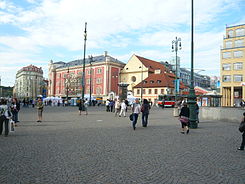Republic Square (Prague)
| Republic Square | |
|---|---|
| Square in Prague | |
 Republic Square as seen from the House of Representatives |
|
| Basic data | |
| place | Prague |
| District | Prague New Town |
| Created | 19th century |
| Confluent streets | Hybernergasse (Hybernská), Am Graben (Na příkopě), Zeltnergasse (Celetná), Elisabethgasse (Revoluční) u. a. |
| Buildings | Shopping centers, state houses, residential buildings, fountains, powder towers, theaters |
| use | |
| User groups | Road traffic , tram |
| Technical specifications | |
| Square area | 19,000 m² (irregular) |
The Republic Square ( Náměstí Republiky ) is a traffic-rich place on the border between the Old Town and the New Town with a variety of attractions and shopping. It is not sharply defined. The subway station of the same name is located under the square .
Heuwaagsplatz
The Heuwaagsplatz ( Senovážné náměstí ) was the economic center of the lower, northern part of the New Town of Prague . The medieval hay and straw market is generally equated with today's Heuwaagsplatz.
According to Wilfried Brosche, however, it is likely that the Heumarkt was planned in a similar way to the Rossmarkt (today's Wenceslas Square ). After that, today's Hybernergasse ( Hybernská ulice ) formed the southern boundary of the market. It was the first street in the New Town to be paved as early as 1379 ( strata lapidae ) and thus received its older name Pflastergasse ( Dlážděná ulice ). The market ran along an old road to Kutna Hora ( Kutna Hora ) and was the main link to the east. The upper end was formed by the mountain or St. Vitus Gate ( Horská brána ) in the walls of the new town .
Hyberner house
The lower end of the original hay market was in the area of today's Republic Square. Here, too, was Charles IV. , A monastery built, today Hyberner house ( U Hybernů ). In 1355 he settled the Benedictines of the Milan Rite. The monastery and church were consecrated to St. Ambrose to commemorate Charles' coronation as King of Lombardy on January 5th of the same year in the Milan Cathedral, of which the saint had been bishop in the 4th century.
This church was also destroyed during the Hussite Wars . After 1483, Bohemian Franciscans settled there . From 1630 the monastery was rebuilt south of the old location by Irish Franciscans (Hybernern). The new Marienkirche was probably built by Carlo Lurago 1652–59 as a monastery church. Under Joseph II , the monastery was secularized in 1786 and the church in 1790 and used as a theater. Once again, the shape of the building changed from 1808-11 through conversion to a customs office, whereby the tower was lost. The Hyberner-Haus is one of the very few classicist buildings in the city and the most striking representative of high classicism . The former church was converted into an exhibition hall in 1940-42 and after the Second World War until 1949.
Powder tower
In 1475 the builder and stonemason Matthias Rejsek started building the tower. In 1484, the work was interrupted when King Vladislav II moved his seat of government from the royal court to Prague Castle on the Hradschin . From 1875 to 1886 the tower was extensively restored by Josef Mocker .
Royal Court and Municipal House
In the place of the community or representative house ( Obecní dům ) stood the royal court as the residence of the Bohemian rulers from the end of the 14th to the end of the 15th century. After Wenceslas IV had acquired several houses on the city wall in the old town, he had the royal court built, to which he moved from Prague Castle in 1383 . Prague Castle was only expanded again under Vladislav II Jagiello and the court moved back to the castle one year after the Prague uprising of 1483, in which the town halls were stormed and the city elders were killed.
In 1631 Archbishop Ernst Adalbert von Harrach set up an archbishop's seminar here. The St. Adalbertskirche was built between 1694 and 1696. From 1777 the former royal court was used as barracks with a cadet school and was demolished in 1903/04.
Between 1906 and 1912, the House of Representation or Municipal House was built in its place in the so-called secession style , in which the sovereignty of the Czechoslovak Republic was proclaimed on October 28, 1918 .
Shopping
During the construction of the Kotva department store in 1971, archaeological excavations revealed the remains of the St. Benedict Church (built around 1233) and the associated Teutonic Knights and parts of the Gothic city wall of Prague's old town .
The Palladium shopping center , which opened in 2007 in the building of the old Josefskaserne, is also located on the square .
Web links
Coordinates: 50 ° 5 ′ 17.5 " N , 14 ° 25 ′ 42.8" E

